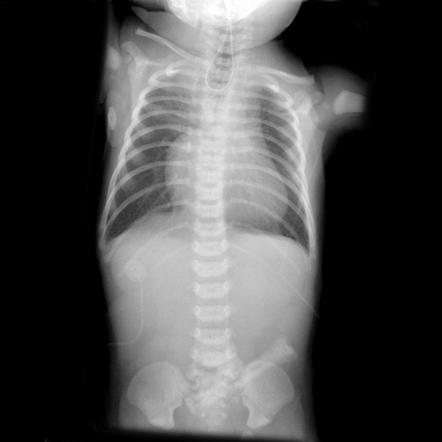What is the most common cause of stridor in infants?
Laryngomalacia
Name 4 indications for a tracheostomy.
•Bypasses upper airway obstruction
•Pulmonary toileting
•Prolonged intubation
•Prophylactic airway protection (ex: aspiration)
Name a consequence that can arise as a result of chronic aspiration.
Bronchiectasis
What salivary gland produces the most amount of saliva at rest?
Submandibular glands
What is a laryngeal cleft?
•An opening between the esophagus and the larynx that isn’t supposed to be there.
•As a result, solids/liquids can enter the wrong tube.
What diagnostic test do you order to diagnose epiglotitis and what to look for?
Lateral neck x-ray
Thumb sign
Idiopathic
•Especially bilateral
Central nervous system (CNS)
•Chiari malformation, CP, Hydrocephalus, meningomyelocele
Iatrogenic injury
•Birth trauma
***cardiac surgery can lead to recurrent laryngeal nerve damage
What is esophageal manometry?
•A diagnostic test that involves inserting a thin probe into the esophagus via the nose.
•The probe measures the pressures/esophageal contractions of different parts of the esophagus.
No need to be concerned.
The effect of botox is not immediate. It can take a few weeks to show its full effect.
Clinical manifestations of bilateral VC paralysis.
Breathing difficulties
•Stridor (biphasic)
•Increased WOB
•SOB
Normal voice (stuck in adduction position)
Normal cry
Feeding difficulties
Name (3) reasons to refer to ENT for a patient with croup.
•Any infant less than 6 months
•Any children >6 years old
•> 2-3 episodes a year of croup
•Prolonged croup course
•Poor response to standard therapy
•History of prior intubation
•Specifically prolonged intubation
•Croup requiring intubation
Name 3 indications for surgery for an infant with laryngomalacia.
Presence of 3 is indication for surgery
dyspnea at rest +/- severe dyspnea during effort
feeding difficulties
FTT
OSA
uncontrollable GERD
history of intubation for obstructive dyspnea
effort hypoxia (>10% of normal)
effort hypercapnia (>10% of normal)
abnormal PSG with an increased AHI
What test to order if there's no clear cause to the patient's dysphagia.
If there’s no clear cause or reason for the patient's dysphagia, a brain MRI is ordered to rule out any CNS causes that could contribute to their dysphagia
•Ex: Chiari malformation
Name 4 side effects of anticholinergic medications.
Tachycardia
Constipation
Urinary retention
Dry mouth
Blurred vision/dry eyes
Drowsiness/dizzyness
Consequences of drooling
Social impact
Isolation
Skin breakdown
Dehydration
Aspiration pneumonia/recurrent resp infections
Name the 3 ATYPICAL features to laryngomalacia.
Expiratory component
Hoarse/weak cry
No change with position/agitation
Treatment for adenoid hypertrophy.
If infectious: treat with antibiotics
Intranasal corticosteroids x 2-3 months (ex: Avamys, Nasonex)
•No improvement with INCS and still symptomatic: adenoidectomy (total or partial)
If severe OSA detected on sleep study will need surgery ASAP
•MOS 3: 1 month
•MOS 4: 2 weeks
Name ways of managing dysphagia.
Positioning techniques
Oral motor therapy
Pacing techniques
Use of thickener for liquids
Reflux management
Surgical management
Difference between anterior and posterior drooling.
Anterior drooling
•Saliva that leaves the mouth
•Visible to others
•Social concerns
Posterior drooling
•Saliva/secretions that pools in the hypopharynx
•Can be audible to others (ex: gurgling)
•Can lead to an increased risk of pulmonary aspiration of secretions
Clinical manifestations of dysphagia.
•Recurrent respiratory infections
•Failure to thrive/weight loss
•Prolonged feeding times
•Coughing/choking while eating or drinking
•Wet voice after eating/drinking
•Chronic throat clearing
•Sensation of food getting stuck/unable to clear
Name methods of preventing subglottic stenosis.
•Atraumatic intubation
•Smallest size ETT with adequate ventilation
•Low-pressure cuffs, leaks
•Minimize movement (sedation, nasal intubation…)
•Consider medications (steroids, anti-reflux, antibiotics…)
•Consider tracheostomy
When to refer to an airway center?
BAD BLUE FIGS
Birthmarks
Aspiration
Dysphonia
BLUE
Foreign body
Intubation
Growth
Sleep/syndrome

Esophageal atresia
NG coiled in esophagus
No gastric air bubble
When to refer to ENT for drooling?
> 4 years old
Concerns for structural abnormalities
•Large adenoids
•Large tonsils
Recurrent respiratory infections
Impact on quality of life (both patient and family)
Children with neuromuscular, neurological, genetic syndromes
Concerns for airway
Impact on feeding and swallowing
How to treat moderate-severe croup.
Go to ER/Doctor
Steroids
•Decreases laryngeal edema
•Longer acting
Adrenaline (epinephrine)
•Rapid acting
•Constricts arterioles thus decreasing edema
•Wears off in 2 hours
•Can have rebound symptoms
Oxygen
Severe cases: intubation